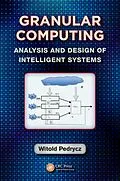Information granules, as encountered in natural language, are implicit in nature. To make them fully operational so they can be effectively used to analyze and design intelligent systems, information granules need to be made explicit. An emerging discipline, granular computing focuses on formalizing information granules and unifying them to create a coherent methodological and developmental environment for intelligent system design and analysis. Granular Computing: Analysis and Design of Intelligent Systems presents the unified principles of granular computing along with its comprehensive algorithmic framework and design practices.
- Introduces the concepts of information granules, information granularity, and granular computing
- Presents the key formalisms of information granules
- Builds on the concepts of information granules with discussion of higher-order and higher-type information granules
- Discusses the operational concept of information granulation and degranulation by highlighting the essence of this tandem and its quantification in terms of the associated reconstruction error
- Examines the principle of justifiable granularity
- Stresses the need to look at information granularity as an important design asset that helps construct more realistic models of real-world systems or facilitate collaborative pursuits of system modeling
- Highlights the concepts, architectures, and design algorithms of granular models
- Explores application domains where granular computing and granular models play a visible role, including pattern recognition, time series, and decision making
Written by an internationally renowned authority in the field, this innovative book introduces readers to granular computing as a new paradigm for the analysis and synthesis of intelligent systems. It is a valuable resource for those engaged in research and practical developments in computer, electrical, industrial, manufacturing, and biomedical engineering. Building from fundamentals, the book is also suitable for readers from nontechnical disciplines where information granules assume a visible position.
Autorentext
Witold Pedrycz, Ph.D., is Professor and Canada Research Chair (CRC) in Computational Intelligence in the Department of Electrical and Computer Engineering, University of Alberta, Edmonton, Canada. He is also with the Systems Research Institute of the Polish Academy of Sciences, Warsaw, Poland and King Abdulaziz University, Saudi Arabia. In 2009, Dr. Pedrycz was elected a foreign member of the Polish Academy of Sciences. He is a Fellow of the Royal Society of Canada, the Institute of Electronic and Electrical Engineers (IEEE), International Fuzzy Systems Association (IFSA), International Society of Management Engineers, Engineers Canada, and The Engineering Institute of Canada. He is editor-in-chief of Information Sciences and editor-in-chief of IEEE Transactions on Systems, Man, and Cybernetics, Part A. He currently serves as an associate editor of IEEE Transactions on Fuzzy Systems and a number of other international journals. In 2007, he received the prestigious Norbert Wiener award from the IEEE Systems, Man, and Cybernetics Society. Dr. Pedrycz is a recipient of the IEEE Canada Computer Engineering Medal. In 2009, he received a Cajastur Prize for Soft Computing from the European Centre for Soft Computing for "pioneering and multifaceted contributions to granular computing." In 2013 he received a prestigious Killam Prize.
Inhalt
Information Granularity, Information Granules, and Granular Computing
Information Granularity and the Discipline of Granular Computing
Formal Platforms of Information Granularity
Information Granularity and Its Quantification
Information Granules and a Principle of the Least Commitment
Information Granules of Higher Type and Higher Order
Hybrid Models of Information Granules
A Design of Information Granules
The Granulation-Degranulation Principle
Information Granularity in Data Representation and Processing
Optimal Allocation of Information Granularity
Key Formalisms for Representation of Information Granules and Processing Mechanisms
Sets and Interval Analysis
Interval Analysis
Fuzzy Sets: A Departure from the Principle of Dichotomy
Rough Sets
Shadowed Sets as a Three-Valued Logic Characterization of Fuzzy Sets
Information Granules of Higher Type and Higher Order, and Hybrid Information Granules
Fuzzy Sets of Higher Order
Rough Fuzzy Sets and Fuzzy Rough Sets
Type-2 Fuzzy Sets
Interval-Valued Fuzzy Sets
Probabilistic Sets
Hybrid Models of Information Granules: Probabilistic and Fuzzy Set Information Granules
Realization of Fuzzy Models with Information Granules of Higher Type and Higher Order
Representation of Information Granules
Description of Information Granules by a Certain Vocabulary of Information Granules
Information Granulation-Degranulation Mechanism in the Presence of Numeric Data
Granulation-Degranulation in the Presence of Triangular Fuzzy Sets
The Design of Information Granules
The Principle of Justifiable Granularity
Construction of Information Granules through Clustering of Numeric Experimental Evidence
Knowledge-Based Clustering: Bringing Together Data and Knowledge
Refinement of Information Granules through Successive Clustering
Collaborative Clustering and Higher-Level Information Granules
Optimal Allocation of Information Granularity: Building Granular Mappings
From Mappings and Models to Granular Mappings and Granular Models
Granular Mappings
Protocols of Allocation of Information Granularity
Design Criteria Guiding the Realization of the Protocols for Allocation of Information Granularity
Granular Neural Networks as Examples of Granular Nonlinear Mappings
Further Problems of Optimal Allocation of Information Granularity
Granular Description of Data and Pattern Classification
Granular Description of Data-A Shadowed Sets Approach
Building Granular Representatives of Data
A Construction of Granular Prototypes with the Use of the Granulation-Degranulation Mechanism
Information Granularity as a Design Asset and Its Optimal Allocation
Design Considerations
Pattern Classification with Information Granules
Granular Classification Schemes
Granular Models: Architectures and Development
The Mechanisms of Collaboration and Associated Architectures
Realization of Granular Models in a Hierarchical Modeling Topology
The Detailed Considerations: From Fuzzy Rule-Based Models to Granular Fuzzy Models
A Single-Level Knowledge Reconciliation: Mechanisms of Collaboration
Collaboration Scheme: Information Granules as Sources of Knowledge and a Development of Information Granules of a Higher Type
Structure-Free Granular Models
The Essence of Mappings between Input and Output Information Granules and the Underlying Processing
The Design of Information Granules in the Output Space and the Realization of the Aggregation Process
The Development of the Output Information Granules with the Use of the Principle of Justifiable Granularity
Interpretation of Granular Mappings
Illustrative Examples
Granular Time Series
Introductory Notes
Information Granules and Time Series
A Granular Framework of Interpretation of Time Series: A Layered Approach to the Interpretation of Time Series
A Classification Framework of Granular Time Series
Granular Classifiers
From Models to Granular Models
Knowledge Transfer in System Modeling
Fuzzy L…
